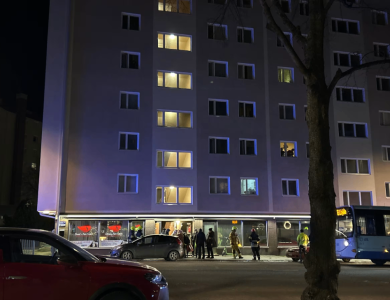
This report addresses a specific event queried by the user, based on information allegedly published by Yle. However, the primary source article referenced () was inaccessible at the time of writing. Therefore, the details regarding the alleged 168 thefts in Lahti could not be independently verified from the provided materials. Other searched information, such as reports concerning a crime in Los Angeles (), legislative documents from Michigan mentioning the name ‘Lahti’ (), book events featuring Christine Lahti (), or commercial product listings (), were found to be unrelated to the specific incident described in the query.)
Introduction: An Unprecedented Case of Repeat Offending Alleged in Lahti
Reports have surfaced concerning the apprehension of a man in the Finnish city of Lahti, suspected of an extraordinary series of thefts. The central claim, which requires verification from the original source, is that this individual is linked to a staggering 168 separate shoplifting incidents over the course of just one year. If confirmed, this case represents a highly unusual pattern of repeat offending within the community.
The alleged events are situated in Lahti, Finland, and purportedly unfolded over the past twelve months. The sheer frequency attributed to one person – averaging nearly one theft every two days – marks this situation as distinct from typical patterns of petty crime. While the specific details await confirmation from the primary source material, the nature of the allegation itself warrants attention due to its potential implications.
The Scale of the Alleged Thefts: 168 Incidents in 12 Months
The core of this story lies in the reported number: 168 thefts allegedly committed by a single individual within a year. This frequency, if accurate, suggests a pattern of behavior far exceeding opportunistic shoplifting. It implies a near-daily compulsion or a systematic approach to theft that demands closer examination. Such persistent activity raises questions about the circumstances enabling it and the potential underlying causes.
Without access to the specific details reportedly published by Yle (), it is impossible to specify the types of goods stolen or the particular stores targeted. Information regarding whether the thefts involved low-value items for personal use (suggesting potential issues like addiction or basic need) or higher-value goods (potentially indicating resale) remains unavailable. Similarly, any estimated total financial loss incurred by retailers cannot be confirmed from the provided materials.
However, the reported scale itself points towards significant potential challenges. A pattern this intense often suggests factors beyond simple criminality. It could reflect deep-seated issues such as severe addiction, untreated mental health conditions leading to compulsive behaviors, or potentially a breakdown in earlier intervention opportunities. The ability to allegedly commit so many offenses before apprehension might also indicate vulnerabilities in preventative systems or detection methods within the affected retail environments or the broader community safety network. Understanding the context – the nature of the goods, the specific locations, any previous interactions with authorities – would be crucial for a complete picture, but this information remains unverified.
The Apprehension: How the Suspect Was Reportedly Caught
Details surrounding the specific circumstances of the man’s capture are also contingent on the inaccessible source material (). It is unknown whether the arrest occurred during the commission of the alleged 168th offense, as a result of accumulated evidence from previous incidents, following a tip-off, or through recognition by vigilant store staff or security personnel.
The method of apprehension often sheds light on the effectiveness of security measures and investigative processes. Was technology like CCTV instrumental? Did coordinated efforts between retailers and police play a key role? Where did the arrest physically take place – within a store, nearby, or at a private residence? Answers to these questions, unavailable without the source report, would clarify the chain of events leading to the end of this alleged year-long series of thefts.
The fact that apprehension reportedly occurred only after such a high number of incidents could also reflect the significant burden such repeat offending places on local resources. Each individual incident, however minor, typically requires documentation and potentially investigation time from both retailers and law enforcement. Tracking and connecting 168 separate events to one individual represents a substantial investigative undertaking. The eventual capture might signify the culmination of these prolonged efforts, highlighting the drain on police and security resources potentially caused by persistent, low-level crime when committed at such an alleged volume.
Police Investigation and Potential Legal Proceedings
Following the reported arrest, the matter would naturally fall under police investigation in Lahti. The current status of the suspect – whether held in custody, released pending investigation, or formally charged – cannot be confirmed from the available information (). Authorities would typically work to consolidate the evidence from the numerous alleged incidents into a comprehensive case file.
In the Finnish legal system, extensive repeat offending, particularly on the scale alleged here (168 counts), would likely lead to significant charges. The specific charges and potential penalties would depend on the exact nature of the thefts, the value of goods involved, and the suspect’s prior criminal record, if any – details unavailable without the primary source report (). Official statements from the Häme Police Department or other relevant authorities would provide clarity on the investigation’s progress and the legal path forward, but such statements were not accessible for this report.
Broader Context and Potential Community Reaction
While specific reactions cannot be confirmed, an incident involving such an extreme number of alleged repeat offenses often reverberates through a community. Retailers in Lahti, particularly if specific stores were repeatedly victimized, would likely face not only direct financial losses from the thefts but also potential costs associated with increased security measures and staff time dedicated to loss prevention. Such events can foster anxiety among business owners and staff.
Furthermore, news of this nature, if widely reported and confirmed, could spark public discussion in Lahti. Conversations might touch upon the effectiveness of local crime prevention strategies, the adequacy of social support systems for individuals potentially struggling with addiction or mental health issues contributing to such behavior, and the perceived responsiveness of the justice system in handling persistent offenders. Cases involving exceptionally high frequency can challenge public confidence and prompt calls for reviews of existing policies and resource allocation for both law enforcement and social services. The alleged scale of 168 thefts by one person inevitably raises questions about how such a situation could persist for a year, potentially impacting community perceptions of safety and security.
Conclusion: Awaiting Verification and Further Developments
The report of a man arrested in Lahti after allegedly committing 168 store thefts within a single year describes a situation far outside the norm for shoplifting offenses. The sheer frequency attributed to the individual, if accurate, points towards potentially complex underlying factors and highlights the significant strain such persistent behavior can place on retailers and law enforcement resources.
However, it is crucial to reiterate that the primary source detailing these events () was inaccessible, preventing independent verification of the core facts presented in the initial query. The information regarding the 168 thefts, the location, and the apprehension remains unconfirmed by the research materials available for this report. Further information, ideally from verified official sources or the original Yle report, is required to substantiate these claims. Until then, the case stands as an unverified but potentially significant local incident awaiting clarification on the facts and subsequent developments in the ongoing police investigation and any resulting legal proceedings



